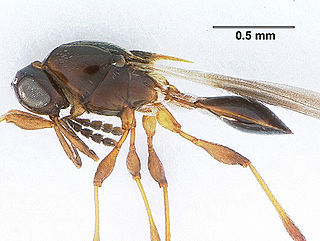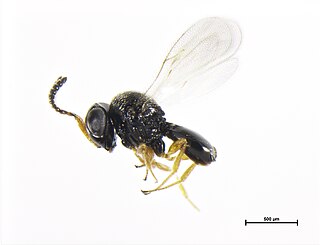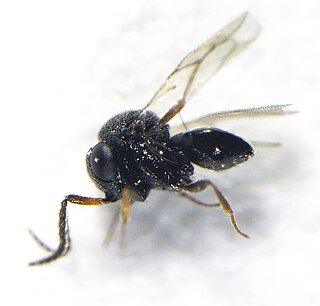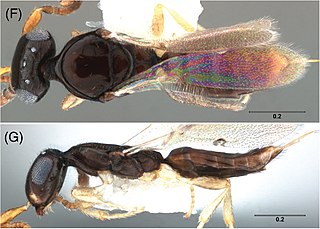
The Hymenopteran superfamily of parasitoid wasps, Platygastroidea, has often been treated as a lineage within the superfamily Proctotrupoidea, but most classifications since 1977 have recognized it as an independent group within the Proctotrupomorpha. It is presently has some 4000 described species. They are exclusively parasitic in nature.

The hymenopteran family Platygastridae is a large group of exclusively parasitoid wasps, mostly very small (1–2 mm), black, and shining, with geniculate (elbowed) antennae that have an eight-segmented flagellum. The wings sometimes lack venation, though they may have slight fringes of setae.

The hymenopteran family Scelionidae is a very large cosmopolitan group of exclusively parasitoid wasps, mostly small (0.5–10 mm), often black, often highly sculptured, with (typically) elbowed antennae that have a 9- or 10-segmented flagellum. It was once considered to be a subfamily of the Platygastridae, but has been revived in the most recent classification of Platygastroidea.

The brown marmorated stink bug is an insect in the family Pentatomidae, native to China, Japan, Korea, and other Asian regions. In September 1998, it was collected in Allentown, Pennsylvania, where it is believed to have been accidentally introduced. The nymphs and adults of the brown marmorated stink bug feed on over 100 species of plants, including many agricultural crops, and by 2010–11 had become a season-long pest in orchards in the Eastern United States. In 2010, in the Mid-Atlantic United States, $37 million in apple crops were lost, and some stone fruit growers lost more than 90% of their crops. Since the 2010s, the bug has spread to the nation of Georgia and Turkey and caused extensive damage to hazelnut production. It is now established in many parts of North America, and has recently become established in Europe and South America.

Rhaphigaster nebulosa, common name mottled shieldbug, is a species of stink bug in the family Pentatomidae.

Telenominae is a subfamily of parasitoid wasps in the family Scelionidae. It was previously considered a subfamily of Platygastridae.

Telenomus podisi is a species of egg parasitoid wasps described by William Harris Ashmead in 1893 and placed in the family of Platygastridae. It is a parasitoid of the brown stink bug, Euschistus heros and can be raised in labs on the eggs of Cosmopepla lintneriana, Podisus maculiventris, and Euschistus servus. This wasp can be used in integrated pest management to control E. heros. The insecticide Imidacloprid is lethal for these wasps, and other insecticides have been shown to negatively impact rates of egg parasitism.
Synopeas is a genus of parasitoid wasps in the family Platygastridae. There are about 400 described species in Synopeas.
Oethecoctonus is a genus of parasitoid wasps in the family Platygastridae. There are about six described species in Oethecoctonus.

Teleasinae is a subfamily of parasitoid wasps in the family Scelionidae. It was previously considered a subfamily of Platygastridae.

Trissolcus is a genus of parasitoid wasps in the family Platygastridae. There are at least 180 described species in Trissolcus. They parasitize eggs of Pentatomorpha.

Trissolcus basalis, or the green vegetable bug egg parasitoid, is a parasitoid wasp in the family Platygastridae known primarily for parasitising the horticultural pest Nezara viridula, the green vegetable bug.
Idris is a genus of parasitic wasps in the family Platygastridae, containing about 160 described species. This genus is part of the tribe Baeini, which are egg parasitoids. Members of the genus Idris are mostly parasitoids of spider eggs, but at least one member of the genus uses stink bugs as hosts.

Proterosceliopsis is an extinct genus of platygastroid parasitic wasp, known from the Mid-Cretaceous of Eurasia. The genus was first described in 2014 from the Albian amber of the Escucha Formation. In 2019 additional species were described from the Cenomanian-age Burmese amber, and was placed into the monotypic family Proterosceliopsidae.

Trissolcus oenone is a parasitoid wasp in the family Platygastridae, native to Australia and New Zealand. It parasitises the eggs of stink bugs (Pentatomidae), but little is known about its biology.

Cuspicona simplex, commonly known as the green potato bug, is a herbivorous species of stink bug native to Australia and introduced to New Zealand. It feeds on nightshades. It is primarily known as a pest of potatoes, tomatoes, and other crops in the nightshade family.

Janzenella is a genus of wasp, the only member of the family Janzenellidae within the superfamily Platygastroidea. It contains only a single living species, Janzenella innupta, which has only been collected in Costa Rica. Fossil members of the living species have also been described from Miocene aged Dominican amber. A Late Eocene fossil species, Janzenella theia is known from specimens entombed in Baltic amber.

Geoscelionidae is a family of wasps in the superfamily Platygastroidea. It contains three extant species in two genera, native to South America and Africa, and several other genera known from fossils. It was originally erected as the tribe Geoscelionini within Scelionidae. It was raised to a full family in 2021.

Sparasionidae is a family of wasps in the superfamily Platygastroidea. Known species are parasitoids of the eggs of orthopterans.

Anastatus bifasciatus is a species of parasitoid wasp in the family Eupelmidae. It is native to Europe, and has been harnessed for augmentative biological control against the brown marmorated stink bug, Halyomorpha halys. The study by Haye et al., 2015 especially demonstrates its effectiveness against the European BMSB invasion. It has also been considered as a biological control agent against spongy moth eggs in North America.


















